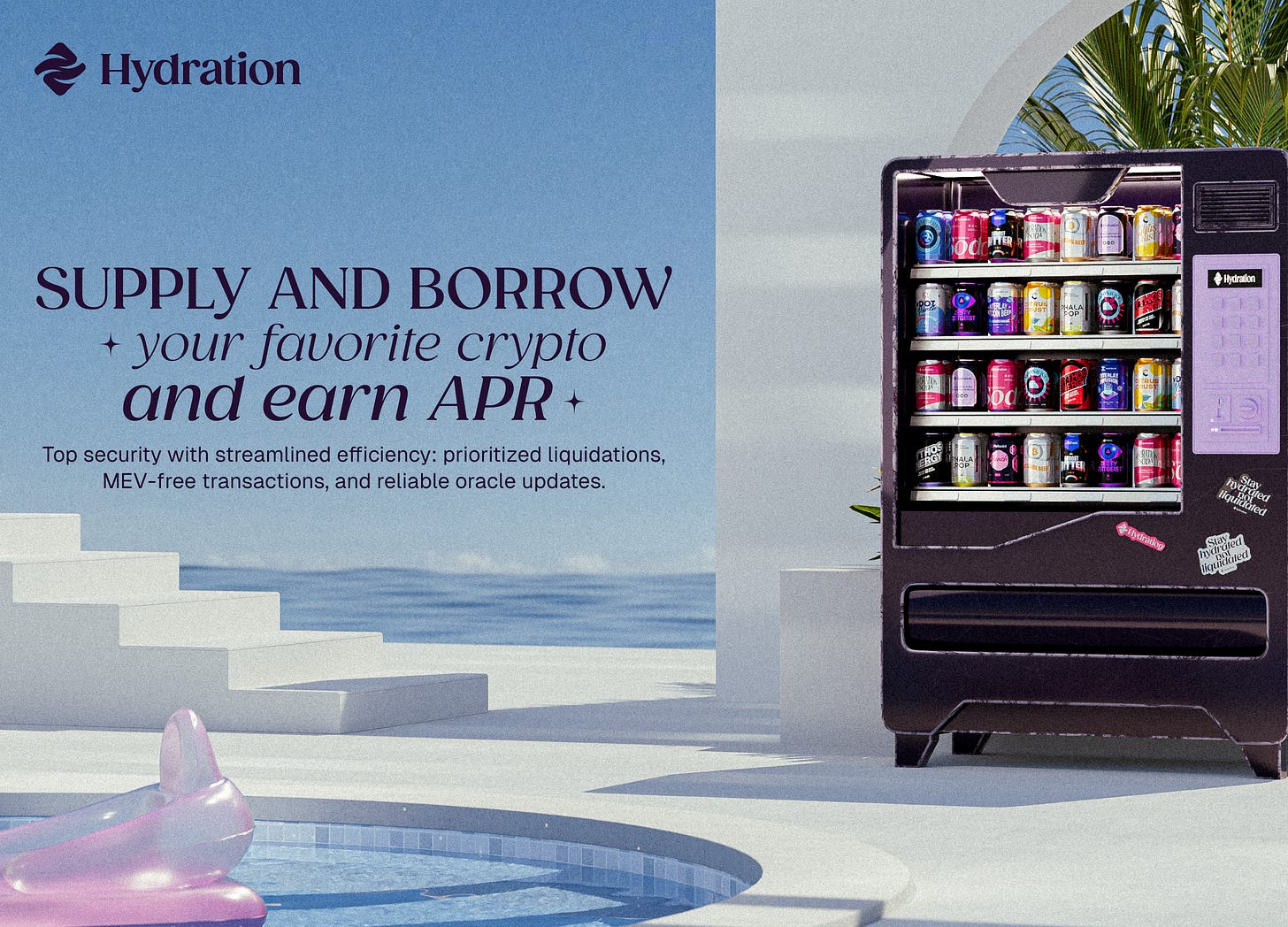💸💦 Borrowing Now Live
The DeFi Renaissance: Hydrated
Dear Hydrators,
It is with great joy and a healthy amount of pride that we announce the launch of the Money Market on Hydration, allowing users to supply their crypto as collateral, earn interest, and borrow against their positions.
This launch is a milestone not only for Hydration and Polkadot, but also for the wider DeFi space. When we started building Hydration 4 years ago, we embarked upon the mission to make DeFi efficient, simple and unstoppable by uniting the three pillars of DeFi under the roof of a scalable app-chain: Trading, Borrowing, and a Stablecoin currency. This informed our choice for Polkadot as the only piece of trustless blockchain infrastructure able to accommodate our vision.
In this post we share our thoughts on the significance of this achievement, reflecting upon why what we are delivering is revolutionary even by today’s standards. We then continue with a brief explanation of how it works, and we round it up with some example use cases which will inspire you to degen like a pro.
The Need of a DeFi Renaissance
The DeFi summer of 2020 brought us something more than a major use case of the blockchain technology. It brought us the prospect of a free world in which everyone can partake in finance. Devoid of the greed and urge to control by governments and large financial institutions alike, DeFi gave rise to powerful slogans: Banking the Bankless, Finance Without Borders, Money Without Middlemen.
Once the initial hype settled down, the shortcomings of early DeFi quickly became apparent. To begin with, the technology was not optimized for “normies” who struggled in finding their way through clunky UIs. Capital inefficiencies further contributed to the bad user experience: It was, simply said, hard to compete with the efficiency of centralized ledgers. Congested blockchains, MEV, high transaction costs, lack of sustainability, and the reliance upon inflation and ponzinomics to attract liquidity only made the problem more evident.
Liquidations - an essential part of any Lending and Borrowing platform, have also traditionally been plagued by inefficiencies. To begin with, lack of prioritization on the Ethereum blockchain meant that liquidation transactions would be queued somewhere between countless other transactions that trade crypto or NFTs, thereby delaying the execution of the liquidation and leading to a greater loss of collateral for the borrower. Furthermore, this opened up various MEV vectors, ranging from frontrunning and sandwiching attacks, to the mere absorption of the liquidation penalty (i.e. the incentive for performing a liquidation) by bots.
The DeFi Renaissance: Hydrated
As the bull got exhausted, it was time to return to the trenches and improve ourselves. Shortly thereafter, we shipped the Hydration Omnipool - a novel kind of AMM that unlocks capital efficiencies by combining all assets in a single trading pool - thereby reducing the hops between pools, and enabling single-sided liquidity provisioning (which played a central role in the onboarding of liquidity and DAOs). To provide the best trading experience, we accompanied the Omnipool with three other AMMs (Isolated Pools, Stable Pools and Liquidity Bootstrapping Pools), all of this wrapped under a user-friendly UI.
But the journey did not end there. We knew that we could unlock greater efficiency and profitability for the Hydration Protocol by building upon the solid bedrock of our trading AMMs the second pillar of DeFi - Borrowing. Liquidations - which occur when a borrowing position risks to become undercollateralized, are among the most profitable on-chain activities.
Leveraging the power of the Polkadot infrastructure, we are again able to flip the paradigm. As the masters of our own block production, we can introduce prioritized on-chain liquidations, making sure that they get executed by our collators at the beginning of every block. This minimizes the losses for the borrowed positions and limits the possibility of frontrunning or sandwich attacks. Furthermore, the whole liquidation penalty (usually 2-5% of the liquidated collateral) can be absorbed by the Protocol Treasury, thereby internalizing this MEV opportunity and opening up a generous stream of Protocol revenue which can be directed to HDX stakers or used for other purposes, as to be decided by Hydration Governance.
How To Supply and Borrow
To enable Borrowing on Hydration, we have deployed a fork of AAVE v3, which is the most sophisticated and secure lending protocol to date. In exchange, Hydration governance has decided to accumulate the AAVE token in its POL, and we will be exploring more ways to work together with AAVE to become the official AAVE fork of Polkadot.
If you are unfamiliar with AAVE, here is how the process roughly works. Anyone can supply collateral in one of the accepted crypto assets on the Platform. After doing so, the position starts accumulating yield, with the APR being determined by market forces (supply and demand). Higher demand for a particular asset / lower supply translates to a higher yield for the supplier.
After supplying collateral, users can borrow any other asset against their position. Borrowing is over-collateralized, meaning that - in net terms - users can borrow less than the amount they have supplied. This allows for liquidations to be performed safely, i.e. without putting third-party capital at risk. To prevent a liquidation from happening, borrowers must actively monitor their position and add more collateral (or repay their debt) if their factor deteriorates, meaning that they approach the liquidation threshold.
To supply and borrow, visit the following link:
https://app.hydration.net/borrow
For more information you can consult the following resources:
Product docs - get to know how it works, and learn the key terminology;
Guide - how to supply
Guide - how to borrow and manage risk
To kick off the markets, the Hydration Protocol will supply the following assets into the Money Market from its Protocol-Owned Liquidity (POL):
WBTC
DOT
USDT
USDC
Finally, we would like to mention that during this initial launch phase, the liquidations will be performed in the traditional way, using off-chain bots. However, our revolutionary implementation of on-chain liquidations performed by collators is just around the corner, waiting for an audit.
Example Use-Cases
Borrowing on Hydration can be used as a part of multiple strategies. To begin with, the immediate access to credit can help users cover expenses related to their personal or business needs. Instead of selling their assets that have (perceived) upside potential, users can borrow other crypto against these positions, all of this usually without the need to pay the taxes that are levied upon selling. The resulting capital efficiency - which in TradFi is reserved only for the rich and powerful, is now completely democratized.
Furthermore, users can supply and borrow crypto to create (leveraged) long or short positions on crypto assets. They can do so by borrowing an asset (e.g. USDT) which they expect to underperform their collateral (e.g. BTC). Additionally, they can create a leveraged short on USDT by selling the borrowed USDT for more BTC, and resupplying BTC again as collateral in order to borrow more USDT. This can be repeated several times according to the risk appetite of users.
A final example use-case is arbitrage between borrowing interest rates and other yields. If the interest rate paid for borrowing an asset (e.g. DOT) is lower than the yield from supplying that asset to another venue (e.g. APR from staking or LPing), users can borrow DOT and supply it to the other venue in order to arb the difference between the two rates. Users can increase the profitability of this strategy by supplying and borrowing correlated assets (e.g. DOT / vDOT) by using E-mode, thereby achieving a higher Loan-to-Value (LTV) ratio that allows them to borrow more against their collateral.
Happy borrowing, and don’t forget the name of the game:
Stay hydrated, not liquidated



